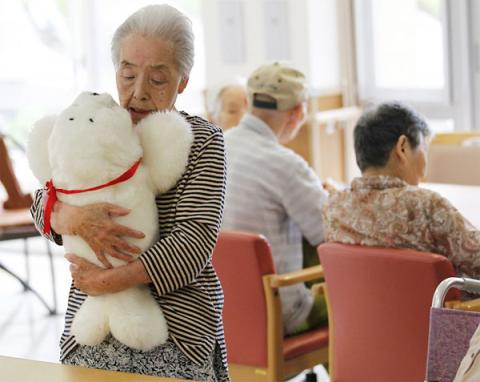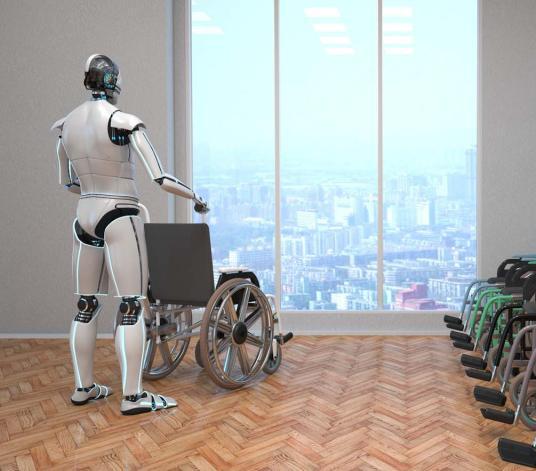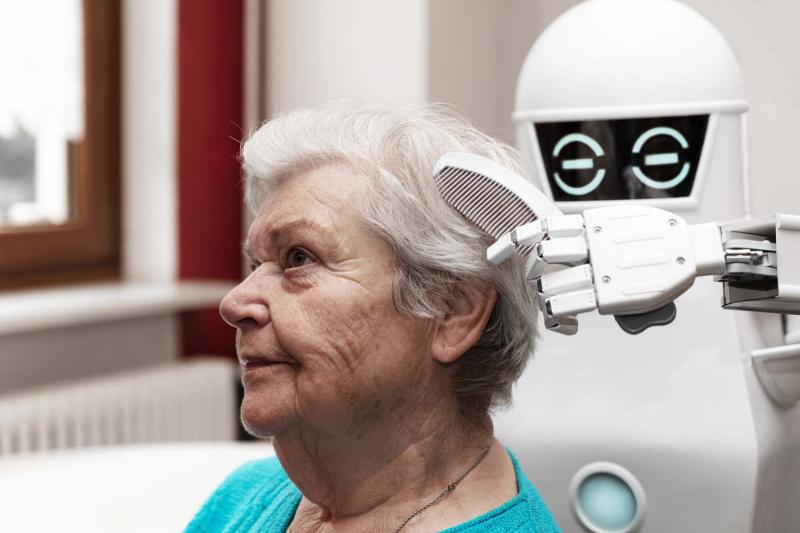Key points
- Robots can play a role in improving the wellbeing of older adults and provide opportunities for social and physical interactions.
- Some older adults have negative attitudes towards robots, which are often based on the mechanical creatures they have seen in Hollywood movies. Others were encouraged by the idea of robots, enjoying their novelty.
- Aged care workers were motivated to learn how to use robots to improve the wellbeing of their clients. Some were fearful that robots would increase their workload, endanger their jobs, and invade privacy.
- Service providers should be aware that despite the benefits, robots should not replace the ‘human’ aspects of aged care. For successful implementation of robots in aged care settings, the workforce needs to be educated in their appropriate and safe use.
Robots are a type of automated machine often designed to carry out routine manual tasks performed by humans. [1] Robots have been used for many years in the manufacturing industry to reduce the need for humans to work in hazardous environments. There are many types of robots. Those that resemble humans (like the one in the image) are known as humanoids. Due to advances in innovative technology, robots can be used for a range of different functions in a variety of settings. In a medical context, robots are being used to carry out surgery resulting in smaller incisions and reduced risk of infection. [2] Socially assistive robots are more often seen in hospitals and residential aged care. As these robots are integrated with artificial intelligence (AI) systems, they are capable of interacting in more meaningful ways with humans. Social robots have been found to provide physical and emotional comfort, direct social interaction, and assist behavioural management. [3]
This evidence theme summarises one of the key issues we identified as part of a scoping review of research on human factors and technology in aged care. We identified 23 studies on this topic [3-25]. These examined types of robots used in aged care and their potential benefits, older adults’ attitudes towards robots, care workers’ attitudes towards robots, guidance for service providers on introducing robots, and those most likely to accept them. If you require more information on this topic, try using our one-click PubMed searches provided below.
A variety of different robots are already being used in aged care. In conducting our scoping review, we identified several types, including robopets such as PARO [4] and Joy for All (JfA) cat and dog, [6, 11] socially assistive robots (aid humans through social interactions), [3, 7, 16] teleoperated humanoid robots, [26] care robots including the Care-O-bot, [5] Zora, [17] an I-SUPPORT robotic shower system, [14] assistive walking robot, Robovie, [20] and robots that can manage medication. [22] This list is not exhaustive and continues to grow as new innovative robotic devices are designed and introduced to the aged care sector.
Robots are being increasingly used in aged care settings to improve the quality of life for older adults and support care staff in their work tasks. Each type of robot has a specific focus on an area of care with many demonstrating a range of benefits including the capacity to reduce depression, loneliness, anxiety, agitation and improve mobility, communication, and quality of life for older people. The integration of robots into aged care has also been found to stimulate exercise and interaction, [17] and can support care workers to complete their roles efficiently.
The benefits of robots in aged care: PARO the therapeutic robopet

Attribution for Flickr image of Paro. Image via Flickr by Amber Case. CC BY-NC 2.0. https://flic.kr/p/cgUDt9
The robotic seal known as PARO is an interactive robopet that has been found to reduce stress for users and stimulate social interactions between aged care residents, their families, and carers. [3] Exposure to PARO has been shown to relax older adults, reduce agitation, undesirable behaviours (particularly for older adults with dementia) and has been accepted by residents and aged care workers. [19] However, despite the benefits and acceptance of PARO it must be noted that these robotic devices are expensive and not all aged care services will be able to afford these resources or provide access to all residents.
The articles we identified in our scoping review report the perceptions and attitudes of older adults towards the integration of robots into aged care services. In these studies:
- Older adults and their families considered robots useful and enjoyable to support communication. [10]
- Interactions with robotic companion pets enhanced older adults’ wellbeing and quality of life, especially during COVID-19 social distancing restrictions when interactions with animals (and other people) were not possible. [11]
- Family members thought that the use of PARO improved mood, reduced agitation, and provided opportunities for communication for the older person receiving care. [19] Older adults were also encouraged by the novelty of robots to participate in activities and they enjoyed walking alongside a robot (Robovie-R3). [20]
- The use of socially assistive robots evoked both positive and negative feedback from older adults, with features such as the ability to understand human speech viewed positively and lack of spontaneity deemed negative as the robot was perceived as cold an inhuman. [24]
- Some older adults were fearful of the unfamiliar and were affected by their negative attitudes towards industrial-type robots or the mechanical creatures portrayed in Hollywood movies. This reduced their ability to perceive robots as devices that could assist or make life easier. [13]
The robotic shower system was viewed positively as it enabled older adults to be independent and take care of their own personal hygiene. [14] The robotic shower was considered more private than having a human carer present, however, concerns over safety were noted. [14]
Care workers’ attitudes and perceptions for the integration of robots in aged care varied between settings and countries. For example, Japanese aged care workers viewed the usefulness of robots more positively than their Finish counterparts. [9] Aged care workers reported varied perceptions and attitudes towards robots including:
- Being fearful of the introduction of care robots. [8]
- Concern that robots may provide inhumane treatment to clients. [9]
- Fear that healthcare jobs may be endangered. [9]
- Understanding that technology can fail, just as humans can. Some workers stressed the importance of having back up plans in place prior to the use of robots with aged care residents. [13]
- The importance of knowing the client as an individual prior to using a robot with them, [17] as well as the need to personalise the robot to accommodate individual care needs and support acceptance of such technology. [3]
- The motivation to learn how to use robots effectively to improve the wellbeing of older adults receiving care. [17]
- The need for staff education in the use of robots to improve care delivery was highlighted by care workers. [10] Some requested opportunities to participate in technical training to support competency. [25]
- Care workers reported that robots could be useful in supporting regular monitoring of older adults for falls prevention. However, staff voiced the opinion that robots should not replace the human aspects of care. [10, 12]
Aged care workers were particularly concerned about the safety risks involved when using robots in aged care given people receiving care varied in their level of cognitive and physical abilities. Care workers were concerned that robots could:
- Increase workload (due to the need to charge, wipe, disinfect, maintain, and repair them). [12, 17]
- Endanger jobs through increased automation of job functions. [9]
- Increase the risk for older people falling (by causing a trip hazard). [12]
- Invade both staff and client privacy. For example, the cameras integrated in robots were perceived as providing surveillance and unwelcome due to the risk of privacy invasion during times of activities such as washing. [12]
- Reduce human interaction and social connectedness. [17, 21]
- Exclude residents from participating in activities due to the lack of resources (due to the costs of robots) (PARO). [12, 18]
The successful introduction of robots into aged care requires the full support of service providers. Aged care service providers should therefore consider:
- Assisting care workers to understand the benefits of robots for their work routines (e.g., reducing workload and freeing up time to spend with clients) as well as the potential positive impacts robots can have on people receiving aged care services. [9]
- Providing adequate education for staff on the use of robots. [10, 13]
- Raising awareness that despite the benefits, robots cannot replace the ‘human’ aspects of care for older people. [10]
- Providing opportunities for care workers and residents to participate in the design and development of robots for use in aged care settings. [15]
- Equipping the facility with the practical resources needed to operate robots. This includes having sufficient charging points and internet connection. [15]
- Anticipating and preparing the workplace for the challenges that may arise from integrating robots into day to day workflow. [17]
The research tells us that some people are more likely to accept and engage with robots than others. People living in larger, urban cities were slightly more open to robots than those living in rural areas. Older adults were also more likely to accept robots if they were to assist them to remain living independently at home. [15] Unsurprisingly, people with an existing interest in technology and assistive robots were more likely to be positive towards engaging with robots as part of care activities such as walking. [20] Individuals who were open-minded [23] and those with sufficient vision and hearing were more likely to engage with robots, as some smaller robots (such as Zora) were difficult to interact with. [17] In addition, care workers were more likely to support the use of robots for their own family members requiring aged care than those who did not have a professional caring role. [15] Staff who fully understood the potential benefits of robots for clients' wellbeing were also more receptive. [17]
This evidence theme has been informed by the results of a scoping review intended to map the published research in this area. Our findings reflect the current state of the evidence which we note is limited in breadth and quality.
Many of the studies in this theme also reported on ethical considerations and concerns of privacy and cybersecurity surrounding the use of robots in aged care. We present these findings as separate evidence themes.
- Smids J, Nyholm S, Berkers H. Robots in the workplace: A threat to—or opportunity for—meaningful work? Philos Technol. 2020;33(3):503-22.
- Watanabe G. Robotic surgery. 1st ed. Tokyo: Springer Japan; 2014.
- Khosla R, Chu MT, Khaksar SMS, Nguyen K, Nishida T. Engagement and experience of older people with socially assistive robots in home care. Assist Technol. 2021;33(2):57-71.
- Abbott R, Orr N, McGill P, Whear R, Bethel A, Garside R, et al. How do "robopets" impact the health and well‐being of residents in care homes? A systematic review of qualitative and quantitative evidence. Int J Older People Nurs. 2019;14(3).
- Bedaf S, Marti P, Amirabdollahian F, de Witte L. A multi-perspective evaluation of a service robot for seniors: The voice of different stakeholders. Disabil Rehabil Assist Technol. 2018;13(6):592-9.
- Bradwell H, Edwards KJ, Winnington R, Thill S, Allgar V, Jones RB. Implementing affordable socially assistive pet robots in care homes before and during the COVID-19 pandemic: Stratified cluster randomized controlled trial and mixed methods study. JMIR Aging. 2022;5(3).
- Chang W-L. Social shaping of robot adoption in organizational contexts. Diss Abstr Int. 2020;81(6-A).
- Chen X, Frennert S, Östlund B. The use of information and communication technology among older immigrants in need of home care: A systematic literature review. Ageing Int. 2022;47(2):238-64.
- Coco K, Kangasniemi M, Rantanen T. Care personnel's attitudes and fears toward care robots in elderly care: A comparison of data from the care personnel in Finland and Japan. J Nurs Scholarsh. 2018;50(6):634-44.
- Fiorini L, Sorrentino A, Pistolesi M, Becchimanzi C, Tosi F, Cavallo F. Living with a telepresence robot: results from a field-trial. EEE Robot Autom Lett. 2022;7(2):5405-12.
- Fogelson DM, Rutledge C, Zimbro KS. The impact of robotic companion pets on depression and loneliness for older adults with dementia during the COVID-19 pandemic. J Holist Nurs. 2022;40(4):397-409.
- Hung L, Mann J, Perry J, Berndt A, Wong J. Technological risks and ethical implications of using robots in long-term care. J Rehabil Assist Technol Eng. 2022;9.
- Johansson-Pajala RM, Gustafsson C. Significant challenges when introducing care robots in Swedish elder care. Disabil Rehabil Assist Technol. 2022;17(2):166-76.
- Klein B, Schlomer I. A robotic shower system: acceptance and ethical issues. Z Gerontol Geriatr. 2018;51(1):25-31.
- Kodate N, Donnelly S, Suwa S, Tsujimura M, Kitinoja H, Hallila J, et al. Home-care robots – attitudes and perceptions among older people, carers and care professionals in Ireland: A questionnaire study. Health Soc Care Community. 2022;30(3):1086-96.
- Loi SM, Bennett A, Pearce M, Nguyen K, Lautenschlager NT, Khosla R, et al. A pilot study exploring staff acceptability of a socially assistive robot in a residential care facility that accommodates people under 65 years old. Int Psychogeriatr. 2018;30(7):1075-80.
- Melkas H, Hennala L, Pekkarinen S, Kyrki V. Impacts of robot implementation on care personnel and clients in elderly-care institutions. Int J Med Inform. 2020;134.
- Moyle W, Bramble M, Jones C, Murfield J. Care staff perceptions of a social robot called Paro and a look-alike plush toy: A descriptive qualitative approach. Aging Ment Health. 2018;22(3):330-5.
- Moyle W, Bramble M, Jones CJ, Murfield JE. "She had a smile on her face as wide as the great Australian bite": A qualitative examination of family perceptions of a therapeutic robot and a plush toy. Gerontologist. 2019;59(1):177-85.
- Nomura T, Kanda T, Yamada S, Suzuki T. The effects of assistive walking robots for health care support on older persons: A preliminary field experiment in an elder care facility. Intell Serv Robot. 2021;14(1):25-32.
- Tan SY, Taeihagh A, Tripathi A. Tensions and antagonistic interactions of risks and ethics of using robotics and autonomous systems in long-term care. Technol Forecast Soc Change. 2021;167.
- Turjamaa R, Vaismoradi M, Kajander-Unkuri S, Kangasniemi M. Home care professionals' experiences of successful implementation, use and competence needs of robot for medication management in Finland. Nurs Open. 2022;00:1-10.
- Turjamaa R, Vaismoradi M, Kangasniemi M. Older home care clients' experiences of digitalisation: A qualitative study of experiences of the use of robot for medicines management. Scand J Caring Sci. 2022;00:1-10.
- Vandemeulebroucke T, de Casterle BD, Gastmans C. How do older adults experience and perceive socially assistive robots in aged care: A systematic review of qualitative evidence. Aging Ment Health. 2018;22(2):149-67.
- Papadopoulos I, Koulouglioti C, Lazzarino R, Ali S. Enablers and barriers to the implementation of socially assistive humanoid robots in health and social care: a systematic review. BMJ open. 2020;10(1):e033096.
- Chen LY, Sumioka H, Ke LJ, Shiomi M, Chen LK. Effects of teleoperated humanoid robot application in older adults with neurocognitive disorders in Taiwan: A report of three cases. Aging Med Health. 2020;11(2):67-71.
Connect to PubMed evidence
This PubMed topic search is focused on research conducted in aged care settings (i.e., home care and residential aged care). You can choose to view all citations or free full-text articles.


